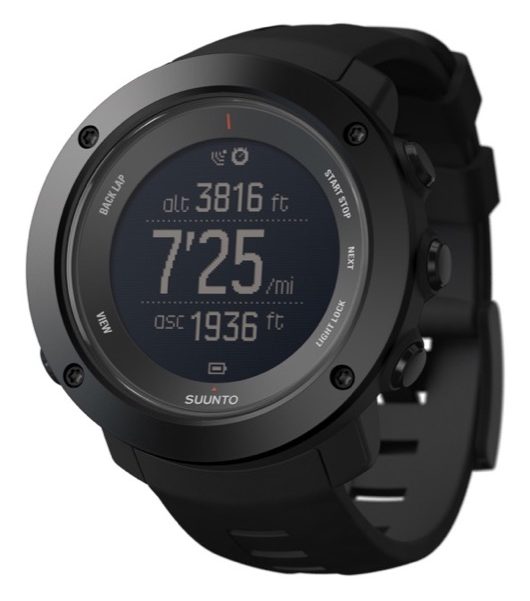 Our reviews are 100% organic. We do not accept payment for reviews or bundle with advertising budgets. In most cases, the brand is providing the product to our reviewers free of charge.
Our reviews are 100% organic. We do not accept payment for reviews or bundle with advertising budgets. In most cases, the brand is providing the product to our reviewers free of charge. Basic summary: The fourth member of the Suunto Ambit3 GPS family (along with the Peak, Sport, and Run), the Vertical has a robust feature set that emphasizes – you guessed it – vertical ascent and descent data. From a functional standpoint, it occupies a middle ground between the Peak and Sport models. The key design innovation with Ambit3 Vertical is the new low-profile GPS antenna that eliminates the distinctive and bulky bump at bottom of the watch face. New features of note are vibration alerts and real time route tracking and altitude profile.
MSRP*: $469 without HR strap, $519 with HR strap
(*Shop around – you can find these watches for less than MSRP from several vendors.)
General features:
- Face dimensions: 50mm tall x 50mm wide x 15mm thick
- Weight: 74 g
- Satellite systems: GPS, GLONASS
- Three GPS recording rates: 1 second, 5 seconds, 1 minute
- GPS battery life: 10 hours, 15 hours, or 100 hours depending on recording rate
- FusedAlti combined GPS and barometric altimeter
- Vibration and sound alerts
Run training features:
- Speed, pace, distance
- Route navigation and track back
- Compass
- Heart rate (with strap)
- Interval workout planner
- Activity based recovery time (with HR strap)
- Sleep recovery test (with HR strap)
- Quick fitness test (with HR strap)
Elevation tracking features:
- Route planner with topographic map
- Download maps from Suunto Movescount or any other online source
- Real time route altitude profile on watch
- Real-time hill incline percentage
- Altitude profile and total ascent visualization graph
- Vertical gain totals per day, week, month and year
- Compatible with Stryd Running Powermeter
- Compatible with Bluetooth Smart power sensors
Connectivity:
- Bluetooth compatible with Android and iPhone
- Data transfer and watch customization via wireless or USB cable
- Auto sync data transfer
- Receives mobile notifications from phone
- Extensive customization through Movescount apps
- Online communities: Suunto Movescount with automatic transfer to Strava and Training Peaks
Deep dive:
Perhaps more than any GPS manufacturer, Suunto is developing an assortment of models with specialized feature profiles that are tailored to specific outdoor activities. In that regard, the Ambit3 Vertical is almost custom made for long distance trail runners who place just as much value on tracking their overall elevation gain and hill performance as they do with weekly mileage. In other words, practically every ultrarunner.
The Ambit3 Vertical has a lower price point than the top of the line Peak model, and a much richer feature package than the Sport or Run models. Like all of the Ambit3 line, construction quality is top of the line, with steel bezel, mineral crystal glass, strong polyamide casing, and a comfortable soft silicone strap.

The most obvious difference in the Ambit3 Vertical is the low profile GPS antenna, which eliminates the bump at the bottom of the watch face; this allows decreased weight (the Vertical is 15g lighter than the Peak) and also helps the device look less like an expedition tool and more like a normal watch. Of course, a lower profile antenna runs the risk of compromising accuracy – and on early versions of this watch, testers reported inconsistencies with distance and route tracking compared to the previous Ambit3 antenna. However, Suunto has issued a number of updates in the life span of the Vertical to address these issues, and in our testing the watch tracked distance and elevation with precision that is equal to or exceeds any other watch we’ve tested. We wore the Ambit3 Vertical in forested trails and narrow canyons without any notable irregularities in GPS tracking.
Suunto further refines its tracking accuracy with its FusedAlti combination of GPS and barometric pressure data, and it can also use Russia-based GLONASS support along with GPS. Interestingly, the barometric functionality of the Vertical is only utilized for tracking altitude changes, without the option of switching to a pure barometer mode for weather forecasting as it does on the Peak. This speaks to the distinction in activity between pure exploration with the Peak and elevation-focused trail running on the Vertical.
From a run training and multisport standpoint, the Ambit3 Vertical is compatible with any sort of workout you choose – whether it’s track work, timed intervals, or sustained tempo runs at a target pace. The addition of a vibration alert is a long overdue feature that makes mile marking or other pre-established intervals more distinctive, but the vibration is rather weak to the point of being almost imperceptible – we’d like for the vibration to be more prominent. You can customize up to eight display screens per sport mode, with a wide variety of data; many of these are set up on the Suunto Movescount website, and others are available as 3rd party apps. Setup and customization of screens can be done through the Movescount app (more on that shortly) or with a USB cable to your laptop, but it can’t be done solely through the watch itself.

Altitude with vertical speed overlay
Obviously from the name, the focus of this watch is – as ultrarunners often say – all about the vert. Your cumulative ascent statistics are tracked and can be displayed in daily, weekly, or monthly views on the watch face or the Movescount app. Vertical speed is continuously monitored and then easily superimposed with elevation data on the Movescount webpage after your run. The Ambit3 Vertical is also compatible with the Stryd footpod, a running power meter similar to the ones cyclists have been using for years.

Power / Pace / Ascent

Weekly Ascent
Probably the coolest new feature on the Ambit3 Vertical is the ability to download route maps, including elevation profiles, directly to the watch. Routes can be downloaded from the Movescount site, which hosts a community-based resource for uploading and downloading routes, but they can also be downloaded from any online GPS file. This is an especially timely innovation, since many races are starting to make GPS files of the course available on their websites. Remember when you used to carry paper cutouts of the race’s elevation profile, or sketch it on your arm with a Sharpie? Those days are gone with the Ambit3 Vertical – now you carry it right inside your watch.

GPS route mapping

Find routes to download
This is especially helpful for runners who are unfamiliar with a race profile and want to gauge their effort in the early miles in order to be prepared for what lies ahead on the course. When tracking your real time route altitude, there is a screen with three data views: one showing the total ascent, one showing the ascent remaining, and a graph showing the altitude profile along with your position marked by a dot. The only downside is that if the course is long (like most ultras), the scale of the route profile is rather small, and there’s no way to zoom in. You’ll easily see the major climbs, but most of the rollers in between will still sneak up on you.

Real time route profile
Battery life in the high accuracy setting is 10 hours, which is enough for a 50-miler if you’re a speedster – but the lifespan may be shorter than the spec depending on how many features you are using, such as route finding or track back. Otherwise, you’ll need to use the “good” accuracy setting (up to 15 hours), or bring along a power stick to recharge along the way; this is easy to do with the Ambit3 Vertical’s secure charging cable.
One frustration we had in using the Ambit3 Vertical was the inconsistency of the sync feature. The device is supposed to auto sync with the Movescount app after a workout is stored, but in our testing this failed up to 25% of the time. If the auto sync fails, you can trigger a manual Bluetooth sync from the watch, but this frequently fails also. The failsafe is to plug the watch into your laptop with the USB cable, and this has proven to be foolproof, but we’d like to see this compatibility tightened up in future updates to the watch.
Conclusion:
The Suunto Ambit3 Vertical has a feature set that is robust enough for a variety of training settings, and the slimmer profile is a significant improvement in weight and comfort without compromising accuracy of tracking. It seems ideally suited for ultrarunners who like to explore unfamiliar routes or race courses, and for those who are interested in tracking their vertical statistics alongside their overall mileage.

